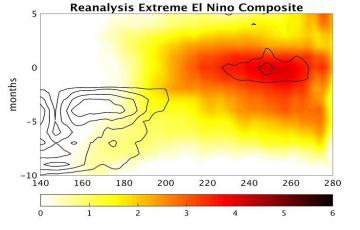Feature Publication Archive
Zhang, Y., M. Feng, Y. Du, H.E. Philips, N.L. Bindoff, and M.J. McPhaden (2018): Strengthened Indonesian Throughflow drives decadal warming in the Southern Indian Ocean. Geophys. Res. Lett., 45(12), 6167–6175, doi:10.1029/2018GL078265.
The first decade of the 21st century witnessed a slowdown in the rise of global surface atmospheric temperatures, referred to as the global warming hiatus. During this time, the tropical Pacific Ocean absorbed more heat from the atmosphere than in previous decades, associated with unusually strong trade winds and a cold phase of the Pacific Decadal Oscillation. However, there is no evidence that the tropical Pacific heat content increased during this time. Where did the excess heat go?
Coincidentally, observations indicated that the upper 700 m of the Indian Ocean gained heat at a... more »
Johnson, G.C. (2017): Overview. In State of the Climate in 2016, Global Oceans. Bull. Am. Meteorol. Soc., 98 (8), S63
Johnson, G.C., J.M. Lyman, T. Boyer, C.M. Domingues, J. Gilson, M. Ishii, R. Killick, D. Monselan, and S. Wijffels (2017): Ocean heat content. In State of the Climate in 2016, Global Oceans. Bull. Am. Meteorol. Soc., 98 (8), S66–S69
Johnson, G.C., J. Reagan, J.M. Lyman, T. Boyer, C. Schmid, and R. Locarnini (2017): Salinity. In State of the Climate in 2016, Global Oceans. Bull. Am. Meteorol. Soc., 98 (8), S69–S75
Feely, R.A., R. Wanninkhof, P. Landschützer, B.R. Carter, and J.A. Triñanes (2017): Ocean carbon. In State of the Climate in 2016, Global Oceans. Bull. Am. Meteorol. Soc., 98 (8), S89–S92.
Overland, J., E. Hanna, I. Hanssen-Bauer, S.-J. Kim, J.E. Walsh, M. Wang, U.S. Bhatt, and R.L. Thoman (2017): Arctic air temperature. In State of the Climate in 2016, The Arctic. Bull. Am. Meteorol. Soc., 98 (8), S130–S131.
NOAA has led, for 27 years, a team of international scientists in issuing annual reports on the state of the climate focusing on the year just passed. The State of the Climate in 2016 report, published as a supplement to Bulletin of the American Meteorological Society in August 2017, is the most recent release of this report. Seven Federal, JISAO (Joint Institute for the Study of the Atmosphere and Ocean, University of Washington), and JIMAR (Joint Institute for Marine and Atmospheric Research, University of Hawaii) scientists resident at PMEL co-authored four of twelve sections in the... more »
McClatchie, S., A. R. Thompson, S. R. Alin, S. Siedlecki, W. Watson, and S. J. Bograd (2016), The influence of Pacific Equatorial Water on fish diversity in the southern California Current System,J. Geophys. Res. Oceans, 121, doi:10.1002/2016JC011672.
Changes in large-scale ocean circulation due to climate change appear to be underway throughout the world ocean and stand to significantly affect marine ecosystems and resources. This new study by McClatchie et al. investigated whether changes in the character of coastal waters over the last 30 years have affected the composition of fish communities in the southern California Current ecosystem. The California Undercurrent transports Pacific Equatorial Water into the Southern California Bight from... more »
Every year NOAA leads a team of international scientists in issuing a report on the state of the climate in the year just passed, published as a supplement to Bulletin of the American Meteorological Society. Nine Federal, JISAO, and JIMAR scientists resident at PMEL co-authored four of twelve sections in the Global Oceans chapter and one section in the Arctic chapter for the State of the Climate in 2015 report, published in July 2016. In addition, Dr. Gregory Johnson served as lead editor of the Global Oceans chapter and participated in the media roll-out event.
Dr. Johnson’s... more »

Composite evolution of extreme El Niño events in WWBs (contours) and anomalous temperature (colors). One WWB early in the year warms the central Pacific making additional WWBs more likely. Many WWBs are necessary to trigger an extreme El Niño event.
Levine, A.F.Z., F.-F. Jin, and M.J. McPhaden (2016): Extreme noise–extreme El Niño: How state-dependent noise forcing creates El Niño-La Niña asymmetry. J. Climate, doi:10.1175/JCLI-D-16-0091.1
Published online. http://journals.ametsoc.org/doi/10.1175/JCLI-D-16-0091.1
A major unanswered question about El Niño-Southern Oscillation (ENSO) is why the largest El Niño events are stronger in magnitude than the largest La Niña events. This paper examines one of the leading hypotheses to explain this asymmetric behavior; namely, that westerly wind bursts (WWBs) create conditions to promote additional WWBs, and the sum total of all the WWBs that occur during the initiation and growth of an El Niño event impacts the eventual magnitude of the event. WWBs are short episodic bursts of westerly winds that occur in the opposite direction of the normal trade winds.... more »


